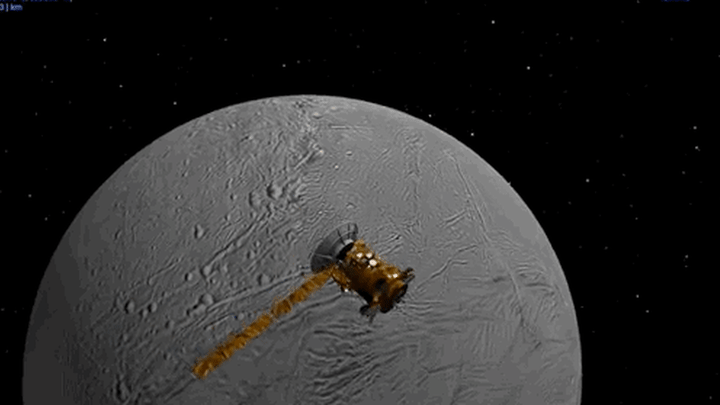Earlier today, the NASA spacecraft Cassini performed a flyby of Enceladus, one of Saturn’s moons. This is the 21st targeted encounter of Enceladus by Cassini, and perhaps its most exciting. The spacecraft flew just 30 miles above the surface of Enceladus at a speed of 19,000 miles per hour. Its mission: To make its deepest dive yet through the icy geysers (or “plumes”) of Enceladus’ south pole. By analyzing the plumes from up close, planetary scientists hope that Cassini’s instruments will be able to reveal more about the internal processes of Enceladus, and thus learn more about its habitability.
WHY ENCELADUS?

The word “moon” sometimes skews our understanding of what scientists are actually studying. A better term for our discussion of Enceladus (and many of the 100-plus other moons in the solar system) is “world.” The ice world of Enceladus is geologically active, which means its surface is changed by internal processes. It is not, in other words, a dead rock in space. There is a liquid ocean beneath its icy crust, and that ocean makes direct contact with a rocky seafloor below. Previous Cassini flights through the plumes have discovered frozen saltwater droplets, molecules containing carbon, and minerals suggesting a hydrothermal system (a system in which hot rock comes into contact with liquid water).
As Jonathan Lunine, a member of the Cassini science team and director of the Cornell Center for Astrophysics and Planetary Science, told the House of Representatives last month, “Make a list of the requirements for terrestrial-type life—liquid water, organics, minerals, energy and chemical gradients—and you find that Enceladus has it all.”
WHAT’S CASSINI?

WolfmanSF, Wikimedia Commons
In 1997, Cassini-Huygens launched from Cape Canaveral, Florida, on a course heading towards the Saturn system. It arrived seven years later (the journey to the outer solar system is a very long one), at which point Huygens, an in situ instrument, detached and landed on Titan, Saturn’s largest moon. Among Huygens’s discoveries: details of the origins of Titan’s nitrogen atmosphere; evidence for possible cryovolcanic replenishment of argon-40 and methane in its atmosphere; remarkably strong winds on that world’s surface; and evidence of a subsurface ocean.
For 11 years, meanwhile, the spacecraft Cassini has been revealing the secrets of Saturn, studying the planet, its rings, and its other moons. “The Cassini mission is incredible,” Curt Niebur, Cassini’s program scientist, said. “The mission has provided nonstop discoveries for 11 years now, and counting.” Some of Cassini’s notable achievements include the discoveries of giant hurricanes at Saturn’s poles; definitive evidence of liquid methane lakes on the surface of Titan; how Saturn’s rings “give birth” to new moons; and of course, the discovery of plumes on Enceladus—a finding that would reshape the Cassini mission.
WHAT DO WE HOPE TO LEARN?
Unless an alien fish is shot from the ocean and slaps against Cassini’s camera lens at just the right time, this flyby will not find life on Enceladus. There is no “life detector” on the spacecraft. By confirming the presence of molecular hydrogen in the plume, however, Cassini’s instruments will provide an independent line of evidence for hydrothermal activity on the seafloor. The amount of hydrogen will reveal just how much hydrothermal activity is taking place. More activity means more energy—energy being a necessary component for life. The spacecraft will also discover more about the chemical makeup of the plumes, and hopefully determine how the plumes operate—whether they consist of independent columns, are part of “icy curtain eruptions,” or have some other characteristics. Taken together, scientists will get a pretty compelling idea of just how habitable Enceladus really is.
The spacecraft took high-res images of Enceladus both before and after the encounter, with the icy south polar terrain lit by reflected light from Saturn. In post-flyby processing, image specialists will remove blurring caused by the Cassini's movement during exposure.
Cassini’s final close flyby of Enceladus will take place on December 19, when from 3106 miles up it will examine how much heat is coming from the moon's interior.
If that doesn’t seem scientifically sexy, consider that 20 years ago there was little hope of finding extraterrestrial life in our solar system. Today, many scientists would be surprised if there weren’t life all around us—whether on Enceladus, Europa, Mars, or even Titan. The scientific, religious, and philosophical implications of this are astounding. If life is found in such close proximity in this small, unremarkable solar system, how prevalent must it be in our galaxy alone? NASA estimates that there may be as many as 100 billion solar systems in the Milky Way. That’s a lot of places for the U.S.S. Enterprise to find “new life and new civilizations.” Today, Cassini went boldly where no one has gone before.
